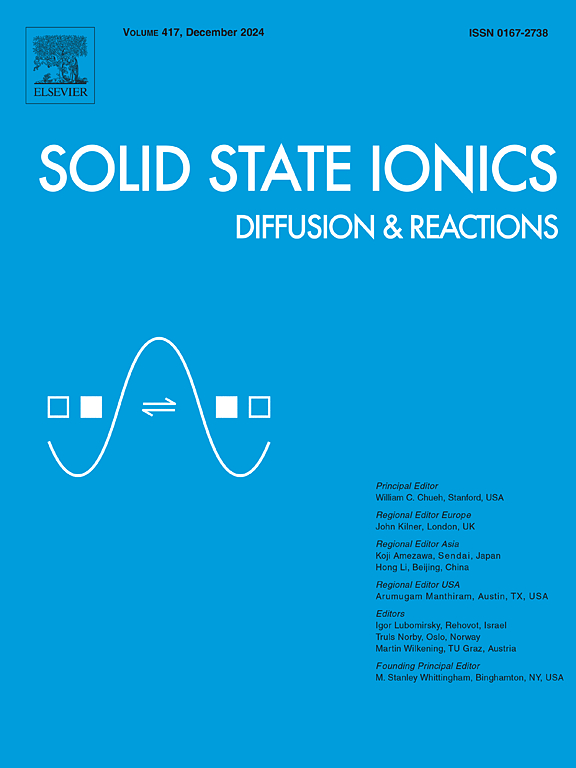通过多层化,降低(La0.5Sr0.5)FeO3−δ电极在环境空气中的降解率和表面偏析
IF 3.3
4区 材料科学
Q3 CHEMISTRY, PHYSICAL
引用次数: 0
摘要
过渡金属钙钛矿氧化物被用作固体氧化物燃料电池和电解槽的空气电极催化剂。然而,涉及碱土取代基的阳离子分离和沉淀的降解限制了它们的商业化。在这项工作中,我们设计了一个多层电极,由超薄(La1−xSrx)FeO3−δ催化剂覆盖层(x = 0,0.5),阳离子迁移抑制Pr0.1Ce0.9O2−δ层和大块传输(La0.5Sr0.5)FeO3−δ层组成。这种“三层”电极结构使表面反应性和稳定性能够独立于体输运进行优化:这种结构可以减轻体储层中可用Sr和其他阳离子的分离,以及它们随后在固气界面的沉淀。这种三层结构降低了表面反应阻力和长期降解,在650°C下超过48小时。该方法为设计具有解耦催化和传输功能的多层电极涂层提供了一般途径。本文章由计算机程序翻译,如有差异,请以英文原文为准。
Reducing the degradation rate and surface segregation of (La0.5Sr0.5)FeO3−δ electrodes in ambient air through multilayering
Transition metal perovskite oxides are employed as air electrode catalysts for solid-oxide fuel cells and electrolyzers. However, degradation linked to cation segregation and precipitation involving alkaline-earth substituents limits their commercialization. In this work, we engineered a multilayer electrode consisting of an ultrathin (La1−xSrx)FeO3−δ catalyst overlayer (x = 0, 0.5), a cation-migration-suppression Pr0.1Ce0.9O2−δ layer, and a bulk-transport (La0.5Sr0.5)FeO3−δ layer. This “trilayer” electrode structure enables the surface reactivity and stability to be optimized independently from the bulk transport: an architecture that mitigates the segregation of available Sr and other cations from the bulk reservoir and their subsequent precipitation at the solid–gas interface. This trilayer architecture reduced surface reaction resistance and long-term degradation by over an order of magnitude at 650 over 48 h. The approach offers a general pathway for designing multilayer electrode coatings with decoupled catalytic and transport functionalities.
求助全文
通过发布文献求助,成功后即可免费获取论文全文。
去求助
来源期刊

Solid State Ionics
物理-物理:凝聚态物理
CiteScore
6.10
自引率
3.10%
发文量
152
审稿时长
58 days
期刊介绍:
This interdisciplinary journal is devoted to the physics, chemistry and materials science of diffusion, mass transport, and reactivity of solids. The major part of each issue is devoted to articles on:
(i) physics and chemistry of defects in solids;
(ii) reactions in and on solids, e.g. intercalation, corrosion, oxidation, sintering;
(iii) ion transport measurements, mechanisms and theory;
(iv) solid state electrochemistry;
(v) ionically-electronically mixed conducting solids.
Related technological applications are also included, provided their characteristics are interpreted in terms of the basic solid state properties.
Review papers and relevant symposium proceedings are welcome.
 求助内容:
求助内容: 应助结果提醒方式:
应助结果提醒方式:


